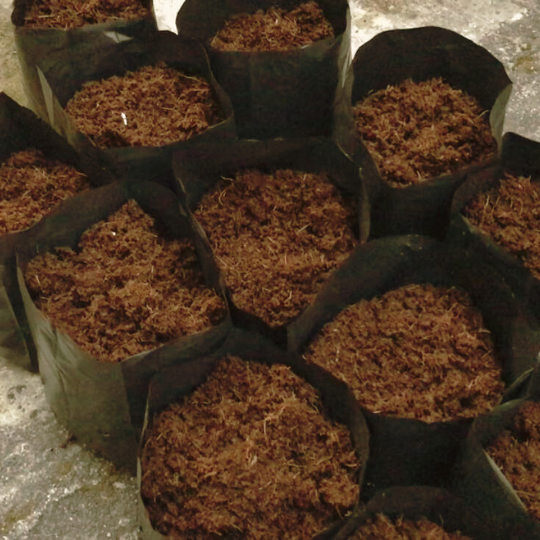
How to use coconut liners for planters can significantly reduce the need for watering by up to 50%. These natural liners not only retain moisture but also provide essential nutrients for healthier plants. By learning how to use them effectively, you can create a thriving environment for your green companions while reducing maintenance efforts. Discover the simple yet impactful ways to incorporate coconut liners into your planters and elevate your gardening game effortlessly.
Benefits of Coconut Liners
Retain Moisture Effectively
Coconut fiber liners are excellent at retaining moisture, keeping the soil damp for a longer period. This helps in preventing frequent watering.
They act as a natural sponge, absorbing excess water and releasing it slowly back to the plants. This ensures consistent moisture levels.
The moisture retention property of coconut liners in baskets is especially beneficial for plants that require constant hydration, such as ferns and certain tropical flowers.
Support Sustainability
Using coconut fiber basket liners in planters supports sustainability due to their eco-friendly nature. These liners are biodegradable and do not harm the environment.
Coconut liners are made from natural and renewable resources, making them a great alternative to synthetic materials. They contribute to reducing plastic waste.
By choosing coconut liners, gardeners can promote sustainable practices and reduce their carbon footprint in gardening activities.
Enhance Aesthetic Appeal
Coconut liners add a rustic and natural look to planters, enhancing the overall aesthetic appeal of the garden or outdoor space.
The neutral color of coconut fiber complements various plant types and colors, creating a harmonious and visually appealing arrangement.
Incorporating coconut liners in planters can elevate the visual appeal of the garden, adding a touch of organic charm to the surroundings.

Choosing the Right Coconut Liners
Select Suitable Size
When choosing coconut liners, ensure they are the right size for your planters to prevent any issues. Consider the diameter and depth of your planters when selecting the appropriate liner size. Ensure that the liner fits snugly inside the planter without being too loose or too tight.
It is crucial to choose coconut liners that are thick enough to hold moisture effectively. Thicker liners help retain water for longer periods, reducing the frequency of watering required. Opt for new coco liners made from high-quality coco fibre fabric for better durability and water retention capabilities.
Consider Liner Thickness
When selecting coconut liners, consider the thickness of the liner material. Thicker liners provide better insulation for plant roots and help maintain consistent moisture levels. Thicker coco liners also tend to be more durable and last longer, offering better support for your plants.
Match Planter Type
Match the type of coconut liner to the planter you intend to use. For hanging baskets, opt for inch round hanging basket liners that fit securely inside the basket. Ensure that the coconut fiber material of the liner complements the design and style of your planter for a cohesive look in your garden or outdoor space.
Step-by-Step Guide to Using Coconut Liners
Prepare the Planter
To begin, ensure that the planter is clean and free from any debris or old soil. Inspect the planter for any damages that may affect the liner’s placement, especially coconut fiber liners. Remove any excess water from previous watering sessions to prevent waterlogging.
Next, trim the coconut liner to fit the planter snugly. Make sure to leave a bit of extra material to fold over the edges of the planter. Smooth out any wrinkles in the liner for a neat appearance.
Insert the Liner
Carefully place the trimmed coconut liner into the planter, ensuring it sits evenly at the bottom. Adjust the liner as needed to ensure a proper fit and coverage. Fold over the excess material at the top of the planter.
For added stability, poke a few drainage holes in the bottom of the coconut liner. This will help prevent waterlogging and promote healthy root growth for your plants.
Add Soil and Plants
Fill the planter with quality potting soil, leaving enough space at the top for your plants. Create small holes in the soil to accommodate your chosen plants. Gently place the plants into their designated spots and pat down the soil around them.
Water your newly potted plants thoroughly and place them in an area with adequate sunlight. Monitor the moisture levels regularly and adjust watering as needed to keep your plants healthy.

Maintenance Tips for Coconut Liners
Watering Techniques
Coconut liners require consistent watering to keep the soil moist but not waterlogged. Water your plants when the top inch of the soil feels dry to the touch.
- Pros: Helps prevent root rot and keeps plants hydrated.
- Cons: Overwatering can lead to mold growth and attract pests.
Fertilization Practices
For fertilization, use a balanced, slow-release fertilizer every few weeks during the growing season. This will provide essential nutrients for healthy plant growth.
- Use organic fertilizers for a more sustainable option.
- Avoid over-fertilizing to prevent nutrient buildup in the soil.
Routine Care and Inspection
Regularly inspect your coconut liners for signs of wear or damage. Replace liners that are deteriorating to maintain optimal plant health.
- Look for mold, pests, or roots growing through the liner.
- Clean liners periodically to remove any debris or salt buildup.
Optimizing Plant Growth with Coconut Liners
Monitor Moisture Levels
To ensure optimal plant growth, regularly check the moisture levels in your coconut planter liners. Use a moisture meter to gauge when watering is necessary. Overwatering can lead to root rot, while underwatering can stunt plant growth.
Maintaining proper moisture levels is crucial for the health of your plants. Coconut coir has excellent water retention properties, helping to keep the soil moist but not waterlogged. This ensures that your plants receive adequate hydration without the risk of drowning their roots.
Ensure Proper Drainage
Good drainage is essential for plant health when using coconut fiber liners. Ensure that your planters have sufficient drainage holes at the bottom to prevent waterlogging. Excess water can lead to root rot and other issues, so it’s vital to allow proper drainage to maintain a healthy root system.
Improper drainage can result in soggy soil, which deprives plant roots of oxygen and can cause wilting or yellowing leaves. By providing adequate drainage, you create a healthy growing environment for your plants, promoting robust growth and vibrant foliage.
Adjust Sunlight Exposure
Sunlight exposure plays a significant role in plant growth. Place your coconut husk planters in locations that receive the appropriate amount of sunlight based on the plant’s requirements. Some plants thrive in full sun, while others prefer partial shade.
Adjusting sunlight exposure based on plant preferences ensures they receive the right amount of light for photosynthesis and overall health. Monitor how your plants respond to sunlight exposure and make adjustments as needed to promote vigorous growth and blooming.

Closing Thoughts
You now have a solid understanding of the benefits of coconut liners, how to choose the right ones, steps to use them effectively, maintenance tips, and ways to optimize plant growth. By incorporating coconut liners into your planters, you are not only enhancing the aesthetics of your garden but also promoting healthier plant growth. Remember to regularly maintain your coconut liners to ensure long-lasting results.
Incorporate these tips into your gardening routine and watch your plants thrive. Experiment with different plants and arrangements to make the most out of your coconut liners. Happy planting!
Frequently Asked Questions
How do Coconut Liners Benefit Planters?
Coconut liners provide natural drainage, retain moisture, and offer insulation to plant roots. They are eco-friendly, reduce the need for frequent watering, and promote healthy plant growth.
What Factors to Consider When Choosing Coconut Liners?
Consider the size and shape of your planter, liner thickness, and material quality. Opt for liners that fit snugly in your planter, have good water retention properties, and are free from harmful chemicals.
What are the Steps to Using Coconut Liners in Planters?
- Measure and cut the liner to fit your planter.
- Wet the liner to make it flexible.
- Place the liner inside the planter.
- Add potting soil and plants.
- Water thoroughly after planting.
How to Maintain Coconut Liners for Longevity?
Regularly check moisture levels, trim any excess liner material, and remove debris to prevent mold or pests. Replace liners if they start to break down or lose their shape to ensure optimal performance.
How Can Coconut Liners Help Optimize Plant Growth?
Coconut liners provide a conducive environment for roots with proper aeration and moisture retention. This promotes healthy root development, reduces transplant shock, and supports overall plant growth and vitality.
In conclusion, if you are eager to delve deeper into the details of coir products, feel free to explore our website at https://cocopeatcocofiberaustralia.com/. Additionally, for direct and instant connection with our team, you can reach us through the following WhatsApp link https://wa.me/61412773364. We look forward to providing you with the information and assistance you need.
